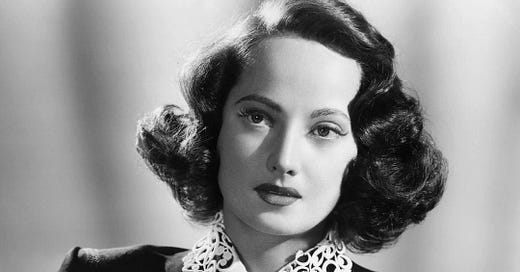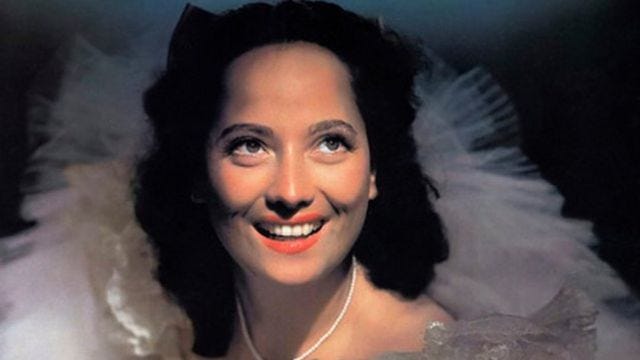(via tcm.com)
In early 1938, respected dramatic actor Laurence Olivier threw a hissy fit when his soon-to-be second wife Vivien Leigh was passed over by Samuel Goldwyn and William Wyler to play Catherine Earnshaw to Olivier’s Heathcliff in Wyler’s 1939 screen adaptation of Emily Brontë’s Wuthering Heights. Instead, Goldwyn and Wyler opted for Vivien’s peer and fellow Brit Merle Oberon. This of course would be no major loss for Viv in the long run, as she quickly made history when she landed the lead role in Victor Fleming’s Gone With the Wind (1939). Though Merle’s career and lasting impact on cinema didn’t become as legendary as Vivien’s or Larry’s; in the late 1930s, she was actually the more popular between the three. It probably didn’t hurt that Merle’s husband at the time was UK cinema titan Alexander Korda; following their first collaboration in Alex’s The Private Life of Henry VIII (1933), Merle’s screen debut. The English beauty rocketed to international stardom as the leading lady in hit films like Harold Young’s The Scarlet Pimpernel (1934), William Wyler’s These Three (1936), Ernst Lubitsch’s That Uncertain Feeling (1941), Julien Duvivier’s Lydia (1941); and of course, reuniting with Wyler on Wuthering Heights. Ironically, Merle and Larry already worked together on Tim Whelan’s romcom The Divorce of Lady X (1938) before clashing during production of the Brontë classic a year later.
Merle not only has the distinction of being one of the biggest movie stars in classic British cinema, but also holds the record for the first woman with Indian ancestry to be nominated for an Academy Award [Best Actress with Sidney Franklin’s The Dark Angel (1935)]. While impressive, this statistic is actually, completely retrospective. As in literally no one knew Merle Oberon was half-Indian until 1983, four years after her death. Born in British occupied Bombay on February 19th, 1911, Merle was originally Estelle Merle ‘Queenie’ Thompson to an English father and Sri Lankan-Māori mother. ‘Oberon’ comes from her paternal grandmother’s surname ‘O’Brien.’
(Herbert Dorfman)
The future actress and her publicist came up with a fake backstory suggesting she was from Tasmania, Australia before immigrating to the UK by the time she was contracted to Alex’s production studio London Films. There was also an extra layer of tragedy to Merle’s real origins, as she was sadly the result of a rape her biological mother experienced as a teen; and grew up under the impression her maternal grandmother was her mother. Through the obligatory celebrity makeover, ‘movie magic,’ strong connections in the film industry via her marriage, and general ignorance regarding race from the time period, Merle managed to convince viewers and colleagues she was another pretty white starlet.
The world is still far from perfect when it comes to community acceptance, but at least we are long past the days of people feeling the need to hide their ethnicity in public. The most depressing part of this big, historical secret is that Merle not only lied about herself, but even tried to convince her friends and acquaintances her mother was her housemaid. This is the real-life equivalent of Fannie Hurst’s Imitation of Life and unfortunately always the first thing I think of whenever I see a photo or reference to Merle. I like Merle generally speaking. I think her acting and screen presence have aged pretty well, and she stands out opposite the other big stars she was cast alongside. I don’t blame her for going to such great lengths to keep her family a secret, as she was just a victim of her generation and knew the truth would affect her career in film.
Merle is still a legend, whether she maintained all those great lead roles from passing as white; or because her first husband was funding nearly all of her hit movies; or because she was legitimately talented. Those classic films and her performances in them hold up contemporarily, and her story is important to entertainment and world history; even with the somber tone of her roots.







What a fascinating story!